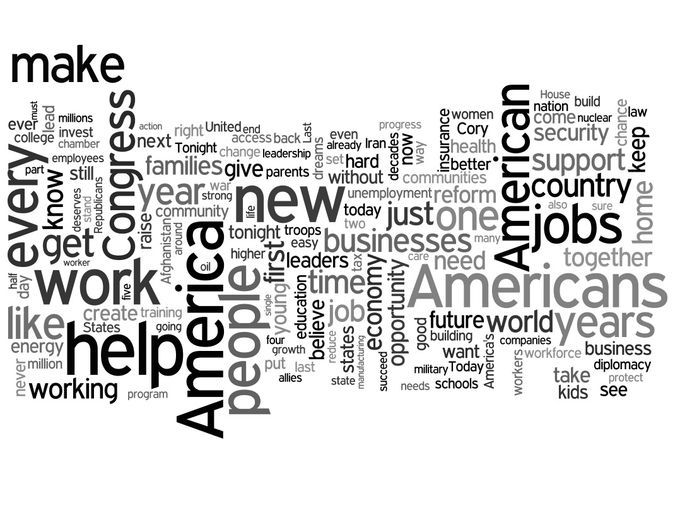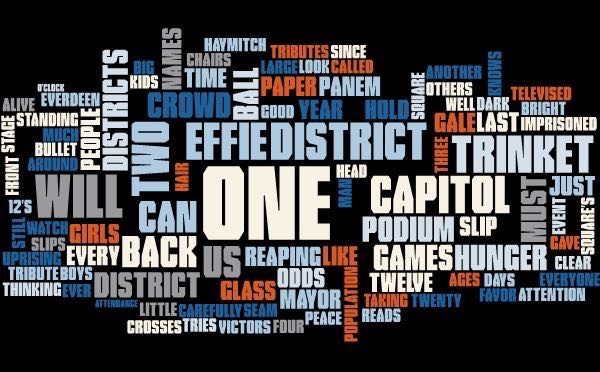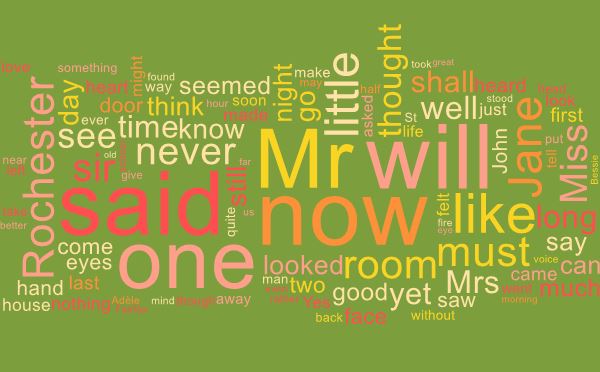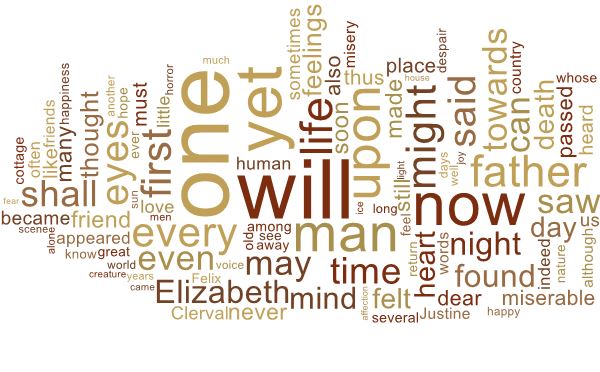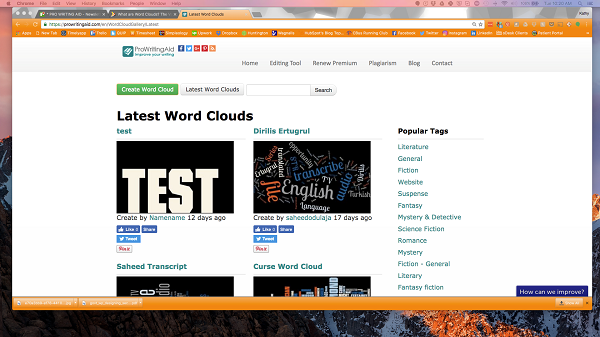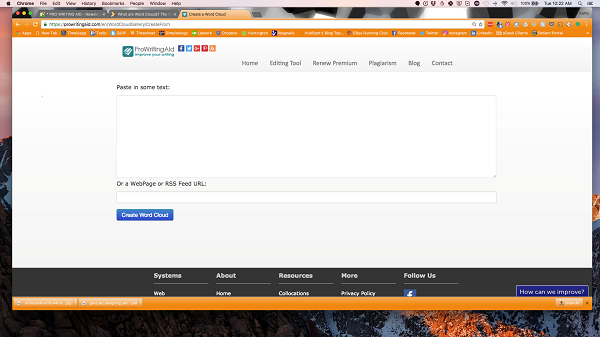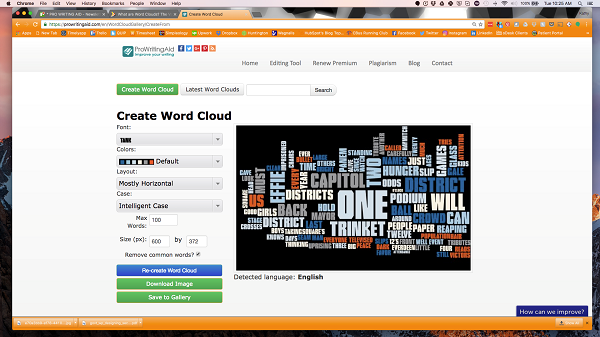Data visualizations (like charts, graphs, infographics, and more) give businesses a valuable way to communicate important information at a glance, but what if your raw data is text-based? If you want a stunning visualization format to highlight important textual data points, using a word cloud can make dull data sizzle and immediately convey crucial information.
When you’re looking at an in-depth data analysis, do you find it difficult to discern which points are the most important?
Anyone who’s ever stared blankly at a lengthy database or long pages of text can relate. With so many insights to comprehend, how do you know where to begin?
Word cloud generators can help simplify this process.
If you’ve ever looked at a jumble of disparate words that seem to have no correlation until you investigate further, you’ve seen a word cloud. These are powerful tools across myriad industries, from art to science.
Today, we’re exploring their use in the field of data visualization. Along the way, we’ll share how your organization can use them to help pinpoint important issues and better direct your steps forward.
Ready to learn more? Let’s get started!
What are Word Clouds?
Word clouds (also known as text clouds or tag clouds) work in a simple way: the more a specific word appears in a source of textual data (such as a speech, blog post, or database), the bigger and bolder it appears in the word cloud.
A word cloud is a collection, or cluster, of words depicted in different sizes. The bigger and bolder the word appears, the more often it’s mentioned within a given text and the more important it is.
Also known as tag clouds or text clouds, these are ideal ways to pull out the most pertinent parts of textual data, from blog posts to databases. They can also help business users compare and contrast two different pieces of text to find the wording similarities between the two.
Perhaps you’re already leveraging advanced data visualization techniques to turn your important analytics into charts, graphs, and infographics. This is an excellent first step, as our brains prefer visual information over any other format.
Yet, what do you do if your raw data is text-based in nature?
Much of the research your organization conducts will include at least some form of an open-ended inquiry that prompts respondents to give a textual answer.
For instance, you might ask current customers what they like or don’t like about your new product line. Or, you could ask them to give suggestions on how your organization could improve. They could also have the chance to elaborate on any pain points they’re experiencing.
There are industry tools that allow you to code such open-ended data so users can understand it quantitatively. Yet, these don’t come cheap. Word clouds offer a cost-effective, yet powerful, alternative.
With these, you can still quantify your text-based insights into measurable analytics. The only difference? You won’t create a chart or graph as you would with a set of numbers.
Instead, you’ll create a word cloud generator to transform the most critical information into a word cloud.
Here’s an example from USA Today using U.S. President Barack Obama’s State of the Union Speech 2012:
As you can see, words like “American,” “jobs,” “energy” and “every” stand out since they were used more frequently in the original text.
Now, compare that to the 2014 State of the Union address:
You can easily see the similarities and differences between the two speeches at a glance. “America” and “Americans” are still major words, but “help,” “work,” and “new” are more prominent than in 2012.
Using word clouds isn’t exclusively for creating presidential eye candy. Keep reading to discover how word clouds can benefit your business.
Where Word Clouds Excel for Businesses
In the right setting, word cloud visualizations are a powerful tool. Here are a few instances when word clouds excel:
- Finding customer pain points — and opportunities to connect. Do you collect feedback from your customers? (You should!) Analyzing your customer feedback can allow you to see what your customers like most about your business and what they like least. Pain points (such as “wait time,” “price,” or “convenience”) are very easy to identify with text clouds.
- Understanding how your employees feel about your company. Text cloud visualization can turn employee feedback from a pile of information you’ll read through later to an immediately valuable company feedback that positively drives company culture.
- Identifying new SEO terms to target. In addition to normal keyword research techniques, using a word cloud may make you aware of potential keywords to target that your site content already uses.
When Word Clouds Don’t Work
As mentioned, word clouds aren’t perfect for every situation. You wouldn’t use a pie chart to show company revenue growth over time, and you shouldn’t use word clouds for every application, either. Here’s when you want to avoid using a word cloud.
- When your data isn’t optimized for context. Simply dumping text into a word cloud generator isn’t going to give you the deep insights you want. Instead, an optimized data set (one handled by an experienced data analysis team) will give you accurate insights.
- When another visualization method would work better. It’s easy to think “Word Clouds are neat!” and overuse them — even when a different visualization should be used instead. You need to make sure you understand the right use case for a word cloud visualization.
There are many other instances when a different visualization should be used over word clouds. (Feel free to contact one of our data analysts to learn more.) More complex data sets and projects require a team of developers and designers for a complete transformation. In could an infographic or dashboard, but word cloud applications are limited to, well, words.
What is a Word Cloud Generator?
As its name implies, an online word cloud generator is a tool that scans a body of text, turning it into component words.
From there, it can create a word cloud that highlights the most frequently mentioned words. If you don’t prefer the cluster shape, most tools enable you to format the word cloud in various ways, including:
- Horizontal lines
- Columns
- Formed to fit a certain shape
Most providers will also allow users to choose different layouts, fonts and color schemes depending on their preference. This means you can make one to match the color scheme of your brand, your partners, or your clients.
While the color used on a word cloud holds a primarily aesthetic value, you can contrast the hues to help categorize words or illustrate a separate data variable.
Why Use a Word Cloud Generator?
Think word clouds aren’t relevant to your organization? Think again.
These are an unexpected yet powerful way to display important data visualizations. Let’s take a look at a few of the top ones.
1. Understanding Client Issues
How are you currently analyzing your customer satisfaction levels? From polls and surveys to social media posts and more, your audience is talking about your brand.
As they do so, they’re delivering valuable insights into the psyche of your target customer. What’s making them tick and what to do they love? Are there any issues that seem to pop up time and again?
It can be difficult to find the answers to these questions if you’re simply reading each comment on an individual basis. Yet, when you create a word cloud with this feedback, you can quickly visualize what everyone is talking about.
For instance, you might notice that phrases such as “wait time” or “attitude” appear to dominate the cloud. This can reveal your customers’ pain points.
Or, you might see positive terms such as “affordable” and “customer service” towering over others, revealing what you’re doing right. Either way, you’ll know which topics to focus on at your next meeting, and you’re already one step in the direction of change.
2. Quickening Business Actions
That important marketing research report just came in at 5:00 p.m. The only problem? It’s 50 pages long.
You’d love to read through it line by line, but you don’t have enough hours in the day, and you’re supposed to give a brief on the data the next morning. This is where a word cloud generator can help.
When you copy the text into the generator and let it do its job, you can see in seconds which talking points appear the most frequently. Then, you’ll know where to start your search to hit the most important parts.
3. Analyzing Employee Sentiment
When you ask employees to share their feedback and opinions about the workplace, what do you do with those responses? It can be difficult to turn this kind of unstructured data into meaningful action if you don’t know where to start.
This is where word cloud visualizations can help.
When you’re able to see which points your employees are discussing at the highest rate, you’ll know how to make valuable and meaningful changes that can boost morale, strengthen company culture, and improve performance.
4. Simplifying Technical Data
You could present highly technical researching findings to a non-technical audience, such as your community board of directors. Yet, when you do so, it’s common to look into an audience of blank stares.
When you present a word cloud instead, you’re able to share the same findings in a more accessible and engaging way. This expands your reach and enables you to share important information in a way that doesn’t require advanced technical understanding.
5. Searching for Patterns in Data
With quantitative data, charts, graphs, and other data visualizations can help you identify key patterns. However, pulling these same insights from qualitative data can prove cumbersome at best and impossible at worst.
A word cloud generator makes this process a cinch. Those words you see overpowering the others? Those are your salient points and overlapping themes.
These would be difficult to find in a tabular format, but they pop out in a word cloud.
6. Search Engine Optimization
You have a good basic grasp on the kinds of keywords that your target audience wants to see. In fact, you might even use a keyword generator to find the most popular ones in your industry niche.
However, do you really know how Google sees your website?
The answer to this question can make or break your Search Engine Optimization (SEO) strategy.
You can use a word cloud generator to see how your content appears to Google bots and similar machines. While it won’t reveal the more technical elements of SEO such as headers, backlinks, and alt tags, it does help you see the general message that your page conveys.
This is important because when Google “looks” at your page, it does so by scanning its content and code. You might think you’re getting the right points across, but do they really dominate? Your word cloud can reveal if you’re giving enough attention to the keywords that matter.
How to Make a Word Cloud
As shown by their increasing popularity, making a word cloud for your website or business isn’t difficult, but there are some important considerations that need to be made so your visualization is more than just eye-candy. While word clouds can be incredible tools for data visualization, it’s important to understand how to use them the right way.
Step 1: Optimize Your Data Set
First, you’ll want to get a valuable, text-based data set. Make sure the data set you’re using is both text-based and optimized for context. Copying and pasting just any textual data into a word cloud generator might not give you the exact insights you need.
Not sure where to begin?
Our team of data analysts is skilled in taking unstructured text and turning it into an optimized data set. First, we’ll help you make sure the source data you’re referencing is both usable and actionable. Then, we’ll compile it in a way that draws out the most interesting and relevant content. Having an experienced analyst compile this helps to ensure your source data is actually usable.
Step 2: Use a Word Cloud Generator Tool
Once your data set is in place, your next step is to run it through a word cloud generator tool. Many businesses like and use Wordle, but there are many others you can try, too (such as Tagxedo and WordItOut). The downside to these free tools is many sites, including Wordle, automatically add all text clouds to their portfolio. This means any site visitor can see it, potentially undermining your marketing efforts. (Check your individual tool’s policies to see if your word cloud will be used in this way.)There are many online resources and apps you can use to perform this step, including:
- Wordle
- Tagxedo
- Tag Crowd
- WordItOut
- Word Cloud Generator for Chrome
- Word Cloud Python tools
- Google Word Cloud tools
Step 3: Export the Word Cloud
Once you create your word cloud, you need to move it from the program to your files. Some platforms will enable you to download the image as a PDF, although many won’t make that easy. In some cases, you’ll have to take a screenshot of the image and save it that way.
Before you close out of the program and start reviewing the data, there’s one security precaution to keep in mind.
While most of the programs above are either free or low-priced, keep in mind that there can be some drawbacks to the convenience they offer. For instance, any time you create a word cloud in Wordle, it saves it to its virtual portfolio.
This might not be a deal-breaker if the data you’re compiling and analyzing isn’t confidential or highly sensitive. Yet, if you work in an industry (such as healthcare or banking) that emphasizes confidentiality and customer data protection, this can render the service unusable.
It’s also a drawback if you’re using a word cloud for marketing purposes. If anyone can search Wordle’s portfolio, there’s nothing stopping them from tapping into your most compelling data.
An easier, safer and all-around better route to take? Create your word cloud from scratch rather than relying on an online program to do the work for you.
Exporting your word cloud from a free tool might take some work. Sometimes, if download as an image or PDF isn’t available, you’ll be forced to take a screenshot – a less-than-elegant solution.
Here’s what to do if you really want your word cloud to be noticed: consider designing your word cloud from scratch!
Does this sound like a lot for you to handle in-house? Not all companies have (or need) an in-house data analyst. Our experienced team at Boost Labs has experience working with enterprise clients such as the U.S. Census Bureau, small businesses like individual websites, and everything in-between.
Creating Your Own Word Cloud
Sure, it’s simple to plug your text into a virtual generator and receive your custom word cloud in seconds. Yet, as we’ve discussed, this can put your most critical data sets in a vulnerable position.
Instead, why not let our team take the reins and create a one-of-a-kind word cloud that’s all yours? This eliminates the risk of your information falling into the wrong hands.
A data visualization expert can also help you pinpoint the most cloud-worthy parts of your unstructured data set so you’re not sifting through tomes of irrelevant data, attempting to make disjointed parts connect.
We’ll work with the most insight-rich parts and deliver a personalized graphic that you can use in your short-term and long-term department planning efforts.
The Best Word Cloud Generators Are Custom
Around the world, we’re creating and sharing more data than ever before and the trend shows no sign of stopping down.
From sales numbers to online traffic rates, you’ve likely got plenty of quantitative data to analyze and discuss. Yet, are you making as much use out of your qualitative inputs?
These are often some of the most insightful data points your organization can leverage. They’re full of opinion, long-form feedback, and personal reflection. Word cloud generators can help make the most of this content, one visual at a time.
Are you ready to discover the power of word clouds for yourself? We’d love to help.
We’re data visualization experts, dedicated to helping companies turn mind-numbing data into interactive and informative graphics, charts, tables and more. Contact us today and let’s discover something new together.
Let us help you with data visualization.
- Author
- Recent Posts
We are living in the age of knowledge-driven economics. Information is an asset, and how we share it defines the extent of our success. We have made major developments in the way we share and exchange information, however, the real game changer throughout this shift has been the emergence of cloud technology solutions.
Cloud computing and technology – popularly referred to as the cloud – has redefined the way we store and share our information. It has helped us transcend the limitations of using a physical device to share and opened a whole new dimension of the internet.
However, while cloud computing is widely recognized by name, few people really understand how it works.
Let’s define and simplify the cloud first to understand what the cloud means, and what it does.
The cloud is a virtual space that exists on the internet. It is a storage space where people can place their digital resources such as software, applications, and files. In simpler terms, we can say that the cloud is virtual storage space on the internet.
A lot of people tend to get the cloud mixed up with the internet. However, the cloud is only one part of the internet.
Cloud computing technology allows people to use digital resources stored in the virtual space by way of networks – often satellite networks. It allows people to share information and applications without being restricted by their physical location.
IF YOU HAVE ANY QUESTIONS ABOUT OUR CLOUD SERVICES:
Simply call us at our Toronto office (416) 657-2449 or our Calgary office (403) 456-2183.
What is cloud computing?
There is a lot of hype surrounding cloud computing, and understandably so – there are major benefits cloud computing brings to the table that are hard to overlook.
BETTER STORAGE
Cloud storage is not limited by the capacity of any physical device. Unlike previous storage solutions, there are no limitations on capacity. This means better and higher storage without worrying about upgrading the memory of a device.
BETTER SCALABILITY
There are a lot of companies that have fluctuating bandwidth requirements. Cloud is a beneficial tool for such clients, since it allows them to scale up when needed by drawing on remote servers. Similarly, you can scale down easily when needed. This scalability is often referred to as the ‘operational agility’ by CIOs of growing brands, and is credited for much of its success.
BETTER COLLABORATION WITH REMOTE USERS
Today’s economy requires workers to work with colleagues across multiple remote locations. Cloud computing makes it easy to share and access digital resources from any part of the globe. This allows for better collaboration between global teams.
HIGHLY AFFORDABLE
Technology cloud computing eliminates the need for physical storage hardware, which reduces the capital expenditure of many companies. These funds can then be appropriated towards innovation or research and development to pave new pathways to success.
For small companies that are still trying to find their footing, purchasing software can be expensive. Instead, such companies can use the software on a pay-per-use basis from the cloud. It is more similar to leasing out a service instead of purchasing it.
DISASTER RECOVERY
It is imperative for businesses of all sizes to invest in disaster recovery protocols. However, this requires money and expertise, which is often lacking in small companies. The cloud gives smaller corporations the ability to implement backup and recovery solutions in a cost-effective and hassle-free manner.
To explore Calgary cloud solutions for your business, get in touch with us at Dynamix Solutions. We can simplify your cloud technology and offer you a consultation on how the cloud can spearhead your business growth.
Frequently Asked Questions about Cloud Technology
What is cloud technology?
What is cloud technology?
In simple terms, cloud technology is a means of storing and accessing programs and data through the internet, rather than using your own computer hard drives.
What technology is a prerequisite for cloud technology to work?
What technology is a prerequisite for cloud technology to work?
The primary enabling technology for cloud computing is usually virtualization. Virtualization software is typically used to separate physical computing devices into multiple virtual devices, each of which can be easily managed and used to perform computing tasks.
Which technology helps share computing and storage?
Which technology helps share computing and storage?
Mobile and cloud computing software provides access to the pool of computing resources that are usually shared, including services, applications, storage, and computers over a network (the internet). It pools various software and hardware components to create an IT environment with shared resources.
What is the difference between the internet and cloud computing?
What is the difference between the internet and cloud computing?
The internet is made up of a network of networks enabling hardware/software infrastructure to establish connectivity of computers worldwide, while cloud computing is a technology that enables users to access resources over the internet. Cloud computing takes place over the internet.
What is hybrid cloud technology?
What is hybrid cloud technology?
Hybrid cloud technology can be defined as a computing model that usually combines a public cloud with a private cloud (on-premises data center) to allow easy sharing of applications and data. Hybrid cloud technology is powerful, as it enables businesses to have more power over their private data.
Front ends allow users to get data and store them using the internet browser in the Cloud storage software. Nevertheless, the backend is the primary Cloud component for storing user data and information. It is comprised of databases, central servers, and computers.
Central servers set rules called protocols that facilitate operations by using middleware and software to enhance the seamless connection amongst devices linked through Cloud computing.
Cloud service providers usually maintain numerous copies of data to minimize the chances of data loss, security threats, and data breaches. Therefore, creating multiple copies of data as a means of backup is known as redundancy.
What are the three types of cloud computing?
What are the three types of cloud computing?
There are three primary types of cloud computing, including Software-as-a-Service (SaaS), Platforms-as-a-Service (PaaS), and Infrastructure-as-a-Service (IaaS). All cloud computing information and services are hosted over the internet.
If you haven’t tried ProWritingAid’s Word Cloud Gallery, get ready to have your mind blown.
Looking to learn more about how ProWritingAid works? Our new eBook gives you all the information you need to start editing like a pro with ProWritingAid.
Download to learn how to customize your settings, use each of our 20+ in-depth reports, install our many integrations, and how you can get the most out of your ProWritingAid subscription.
What is a Word Cloud?
Google says a word cloud is “an image composed of words used in a particular text or subject, in which the size of each word indicates its frequency or importance.”
So, the more often a specific word appears in your text, the bigger and bolder it appears in your word cloud.
ProWritingAid has a Word Cloud Gallery that makes it easy to create word clouds based on the text you paste into the tool. Here’s what a word cloud based on the reaping scene in the first chapter of The Hunger Games looks like:
Below are a couple other word clouds. Can you recognise the novels from their word clouds?
Or, if you are up for a challenge, try our Word Cloud Game. Guess 10 classic novels from the word clouds that they generate.
Word Clouds For Fiction Writers
Every writer has words they like to use over and over. When we edit our own words, it’s hard to see what our overused words are. But when we use them too often, our writing sounds redundant. A word cloud can help you identify your overused words. The most commonly used words are the biggest. It’s easy to see if the big words are the words you want to use the most.
Do you have too many dialogue tags? If so, «said» will show up as a larger word. You can then go find places in your writing to add action or emotion beats. Do your characters smirk or shrug all the time? A word cloud can help you find the actions you repeat too often.
A word cloud can also make sure you are focusing on the right characters, themes, and plot points. If your book is about Jane, but Jack’s name is three times bigger, you might need to re-evaluate your manuscript. If your book is about a war, but the words «war» and «battle» are tiny on your word cloud, you’ll need to develop that plot more.
Word Clouds For Copywriters And Bloggers
Search engine optimization. It can be the bane of copywriters and bloggers everywhere. The algorithms are always changing. But it doesn’t have to be a mystery. The most important part of SEO is keywords.
Run your copy or blog post through a word cloud generator. Are your target keywords huge or tiny? What words have you inadvertently turned into SEO keywords? This will help you figure out exactly what edits you need to make to reach those high search engine rankings.
When To Use Word Clouds
For fiction, you can use word clouds of different scenes to compare how your characters feel about the inciting action. A word cloud will help you notice right away if your characters’ reactions are similar in both scenes. You’ll be able to identify where you should have a new reaction or a new emotion.
For business purposes, word clouds can help you find your customers’ pain points. If you collect feedback from your customers, you can generate a word cloud using customers’ language to help identify what is most important to them. Imagine if “long wait time” cropped up as major emphasis words in customer feedback. That should ring a warning bell.
If you are in the business-to-consumer writing industry, a word cloud will highlight overuse of technical jargon. You can make sure your language is accessible to consumers with a quick visual model.
When Not To Use Word Clouds
Simply dumping a scene from your current work in progress into a word cloud generator might show you that you used “said” a lot, but won’t give you the insights you want. But using word clouds to compare your scenes against each other can show you where they’re too similar, use too many of the same unimportant word choices, or simply aren’t consistent between scenes when they need to be.
Likewise, in copywriting for business, you wouldn’t use a word cloud when your content isn’t optimized for keywords. A word cloud on a blog post that’s not SEO enhanced won’t tell you much about your keyword density.
No matter what you’re writing, word clouds are something to use as a last step in your writing process. Word choice falls under «line edits.» If you have an unedited first draft, word clouds won’t help you much. You’ll likely need to make major structural changes before you use a word cloud.
How ProWritingAid’s Word Cloud Gallery Works
At the bottom of every page on ProWritingAid.com is a link under “Resources” called Word Cloud Gallery. When you click on that link, you get something that looks like this:
Notice at the top, you have options to “Create a Word Cloud” or search for the “Latest Word Clouds” by keyword. A sidebar on the right side contains popular tags to help you narrow your focus on already-generated word clouds.
When you click on “Create Word Cloud,” it brings up the following screen:
Simply copy and paste your text into the box or enter your url, and click on “Create Word Cloud.”
Here’s what your new word cloud looks like:
Notice you have an interesting graphical representation of the words in your text, which you can customize by choosing a font, color, and layout. You can also re-create the word cloud with new text, download the image to your computer, or save it to the ProWritingAid gallery so that others can see and use your word cloud.
Final Thoughts
Word clouds are fun to use as a visual aid with blog posts to underscore the keywords on which you’re focusing. Your readers will notice the larger, bold words and understand their importance to your post.
And for fiction writers, word clouds are great to make sure you’re focusing on the right words in your prose. It’s also interesting to see some of the word clouds in the ProWritingAid gallery that other writers have created, especially those in the genre-specific popular tags in the sidebar on the right.
Play our Word Cloud Game here.
How do you see word clouds helping your writing? Let us know if you’re a fiction writer or copywriter and how you might use a word cloud.
Or if you’ve already created a word cloud on ProWritingAid.com, let us know what insights you gained from it.
In the meantime, happy writing!
Find everything you need to know about using ProWritingAid in our Ultimate Guide. Download the free eBook now:
How to Use ProWritingAid
Join over 1.5 million authors, editors, copywriters, students and business professionals who already use ProWritingAid to improve their writing.

Introduction to Cloud Technology
Cloud computing is the delivery of various internet services. Such tools include data storage, servers, databases, applications, and networks. Cloud-based storage allows you to save files on a central network rather than on a proprietary local storage device or hard disk. So long as an electronic device accesses the internet, the data and software programs are available for use. For many reasons,
Cloud Computing is a popular option for individuals and companies, including cost savings, productivity increase, speed and efficiency, performance, and protection.
What is Cloud Technology?
Cloud computing technology is an on-demand technology where users utilize the IT resources over the internet platform and work on pay-per-use mechanisms instead of the previous subscription-based technologies.
Below are a few points:
- It refers to cloud computing which stores data and resources in an online server, and user fetches the same for their use instead of saving directly in the computer’s hard drive, which is not secured and safe for use.
- Cloud here refers to virtual space or online platform, and the technology becomes widespread where the end users can store large files and applications on remote servers, which gives them the facility to work remotely from anywhere in the world.
- Some of the Cloud technology services provide the end-users to consume the facility at a certain price, where some technology services provide facilities over the network to some specific set of user clients to use the resources.
There are various cloud technology services, which are very popular and widely used in today’s world are huge storage and backup, testing and maintaining apps, analyzing data, and delivering relevant software on demand.
Why we use it?
Cloud computing technology is an internet-driven platform where resources are transferred through channels of networks from server to client that replaces the use of physical hardware and software.
Therefore, in today’s world, where technology is upgrading at the speed of light, it is very important to know which technology to go for and the right use of technology. Thus, cloud technology comes in, and despite having adverse effects on the internet, it remains the fastest technology to work with, and it became the latest trend in today’s market. So the purpose of using it is to diversify resources worldwide by interconnecting customers and giving the business users the to expand their market by retaining their customers in this field by utilizing the proper resources at the right time. The biggest reason, according to me, why everyone uses the cloud is that it provides us with the best backup system of any resources of any file size that can be corrupted or become unusable if kept in a local drive or storage. It has been a tremendous boom in the recent trend of technologies for IT professionals where they can access resources and work from anywhere in the world, making it more flexible to work and handle clients.
Advantages
If I started to write about the benefits we can get from Cloud technology, it would be a never-ending topic since its advantages are vastly eradicating its minor disadvantages.
In spite of that, I have listed down its major advantages that are worth considering:
- Cost Optimization: This technology brings a variety of useful resources that utilise the overall cost and saves the cost. This technology does not require any physical hardware installation, and the user can use it on a pay-per-use basis rather than subscription charges.
- Scalability and Resource Utilization: This technology offers the best scalability by utilizing the resources across the platform, offering better reliability of storage for the users.
- Data Security: Having a huge amount of data stored in one cloud server still provides the best data backup and the security of its resources and makes it readily available for the users whenever they want to do something with it.
- Collaboration and Ease of Use: The cloud technology platform provides an effective collaboration that makes the users to be interconnected from anywhere in the world by using the internet, connected virtually.
- Fast Software Updates of Resources: Software updation and upgradation happen automatically and quickly without any requirement of manual steps to integrate applications of choice.
- High Speed and Flexibility: Cloud computing services are readily available for the clients to work, and the high speed of acquiring and utilizing the resources makes them work from anywhere and anytime.
- Rapid Deployment: The cloud technology platform gives us access to deploy resources faster over the cloud. Thus after deployment, the resources and the system deployed become fully functional and ready for use within a few moments.
Working of Cloud Technology
Cloud Technology nowadays provides a variety of useful services that requires an internet connection, and users can access and download data from any physical device anywhere, anytime they want. The users also are benefitted from the use of various cloud storage providers that provides unlimited free cloud storage spaces minimizing the use of limited spaces available on CDs, DVDs, and pen drives.
The main model of cloud technology works in two layers are:
1. Front End: This end comprises the client or user systems having their own user interface. This end also consists of the necessary resources that the client requires for their use. This end is the receivers that receive the resources through cloud-connected through the internet.
2. Back End: This end comprises the data storage systems and the servers that make up the cloud. It contains a dedicated server to work on cloud performance.
Conclusion
Thus, to conclude, cloud technology is the current renovation in technologies that are the fastest growing and fastest earning technologies, making life easy for every user. The Internet or cloud binds us through its network branching system that makes our lives comfortable and feels safe and secure.
Recommended Articles
This is a guide to What is Cloud Technology?. Here we discuss the basic concept, working, why we use it, along with advantages respectively. You can also go through our suggested articles to learn more –
- Cloud Computing Architecture
- Cloud Computing Service Providers
- Risks of Cloud Computing
- Cloud Security Tools
Asked by: Mr. Keyon Baumbach
Score: 4.2/5
(54 votes)
A tag cloud is a novelty visual representation of text data, typically used to depict keyword metadata on websites, or to visualize free form text. Tags are usually single words, and the importance of each tag is shown with font size or color.
What is word cloud used for?
Word Clouds are visual displays of text data – simple text analysis. Word Clouds display the most prominent or frequent words in a body of text (such as a State of the Union Address). Typically, a Word Cloud will ignore the most common words in the language (“a”, “an”, “the” etc).
What is example of word cloud?
For example, “apples~and~oranges” would appear as “apples and oranges” in the word cloud.
How would you describe a word cloud?
Google says a word cloud is “an image composed of words used in a particular text or subject, in which the size of each word indicates its frequency or importance.” So, the more often a specific word appears in your text, the bigger and bolder it appears in your word cloud.
Are word clouds useful?
Using a word cloud isn’t just a beneficial way to get a feel of the room, it also acts as a perfect way to kick start your presentation. … We’d go so far as to say that word clouds are often best used at the very start of a presentation as it will help familiarise your audiences with the technology and how it works.
20 related questions found
Who invented word cloud?
The notion of network-based computing dates to the 1960s, but many believe the first use of “cloud computing” in its modern context occurred on August 9, 2006, when then Google CEO Eric Schmidt introduced the term to an industry conference.
Can Slido do word clouds?
In Slido, creating a word cloud and running it during an online meeting or event is as easy as 1-2-3.
Which tool is word cloud option?
WordArt.com
WordArt, formerly Tagul, is a popular word cloud generator, known for its wide range of designs. You can customize fonts, layouts, and color, and choose from custom shapes. This tool also offers some pre-processing options like stemming, and removing common words and numbers.
How do I use word cloud?
How to Use MonkeyLearn’s Free Word Cloud Generator
- Upload your data: you can either type, paste, or upload your text to create a word cloud.
- Click on ‘Generate Cloud’
- Customize your results: you can edit the original text, choose a theme, font, and number of words that you want to see in your word cloud.
How do I make a word cloud for free?
Wordclouds.com is a free online word cloud generator and tag cloud creator. Wordclouds.com works on your PC, Tablet or smartphone. Paste text, upload a document or open an URL to automatically generate a word- or tag cloud. Customize your cloud with shapes, themes, colors and fonts.
Can you create word clouds in Excel?
Unlike Tableau Software, Microsoft Excel provides no native feature to create a word cloud (aka tag cloud), i.e. a visual representation of text data where the font size of a word depicts the frequency of this word in a text.
Can I create a word cloud in PowerPoint?
Open the PowerPoint file that contains the text you would like to create a word cloud with and then click the “Insert” tab. Next, in the “Add-ins” group, click “My Add-ins.” The “Office Add-ins” window will appear. … Back in the Pro Word Cloud pane, click the “Create Word Cloud” button.
Why do we create a word cloud?
Word clouds quickly break down text from an article or survey and allow the viewer to see which words are used more or less frequently. The larger a word’s size in the cloud, the more frequently it is used. Creating a word cloud helps engage, educate, and quickly capture your audience’s attention.
How many words are needed for a word cloud?
Each phrase in a word cloud can be between 1-5 words. The word cloud can identify singular and plural words, tense variation, and other similar words and phrases, then groups them together to display as a single word.
Is Microsoft word cloud based?
As it’s a cloud-based, subscription service, the software and services are automatically updated when a new version is released, so you always have access to the latest features and functionality.
What is the best word cloud app?
The 10 best word cloud generators
- WordArt.com. WordArt.com (formerly Tagul) creates stunning images, and is easily one of the best word cloud generators out there. …
- WordClouds.com. …
- Wordle. …
- Jason Davies’ word cloud generator. …
- Abcya.com. …
- TagCrowd. …
- WordItOut. …
- Tagxedo.
What are those word collages called?
Text clouds
A text cloud or word cloud is a visualization of word frequency in a given text as a weighted list.
How do I keep words together in word cloud?
The size of the word in the cloud depends on how many times the word appears in the text box. To make a word appear LARGER, type it MORE times in the text box. Use a tilde symbol ~ to keep two words together in the cloud. Otherwise, the two words will be scattered apart in the cloud.
Which is better Slido or Mentimeter?
Reviewers felt that Slido meets the needs of their business better than Mentimeter. When comparing quality of ongoing product support, reviewers felt that Slido is the preferred option. For feature updates and roadmaps, our reviewers preferred the direction of Mentimeter over Slido.
Can you do word cloud on Zoom?
Open the Zoom dashboard and click on the Settings icon. Select the Virtual Background item then you can choose a virtual background. Click on the + to add a new background then find the . png file of your word cloud.
Who controls the cloud?
The short answer is that you own the data you create, but the cloud service provider has ultimate control over it. This is reflected in many providers’ terms of service which state that they can hold on to the data to comply with legal regulations.
How did the cloud get its name?
The concept of cloud computing dates to the 1960s. The phrase originates from the cloud symbol used by flow charts and diagrams to symbolize the Internet. The diagram to the left underscores the idea that any Web-connected computer has access to a pool of computing power, applications and files.
What can I use instead of a word cloud?
Wordsalad Alternatives
- MonkeyLearn’s Word Cloud Generator.
- Wordle.
- Wordclouds.com.
- Abcya.
- WordArt.


